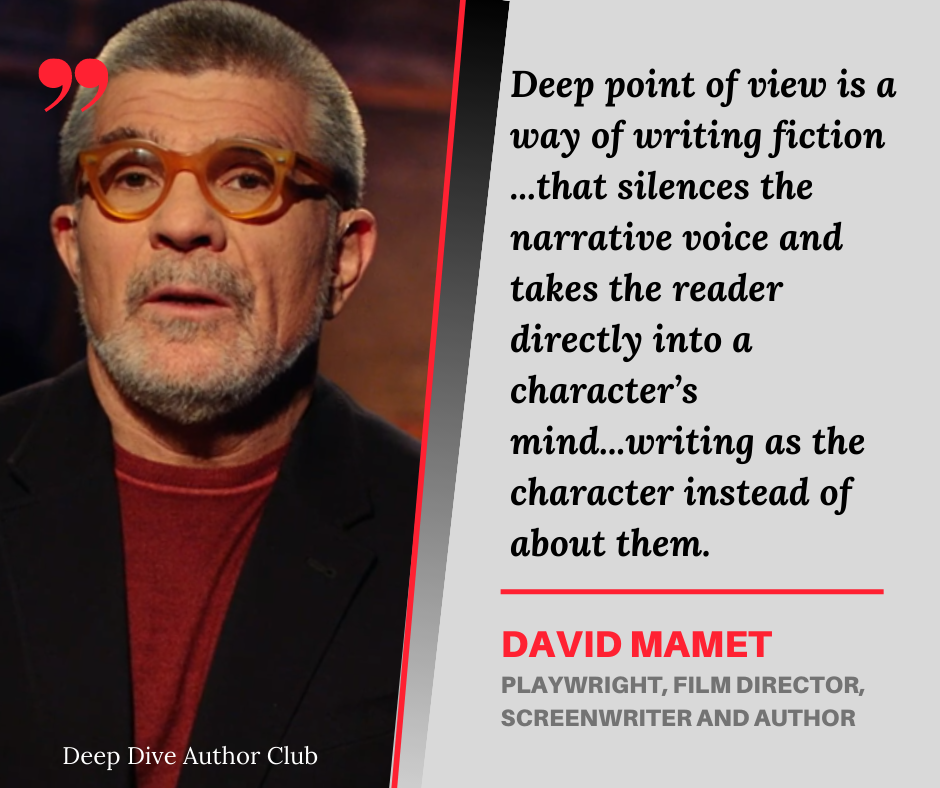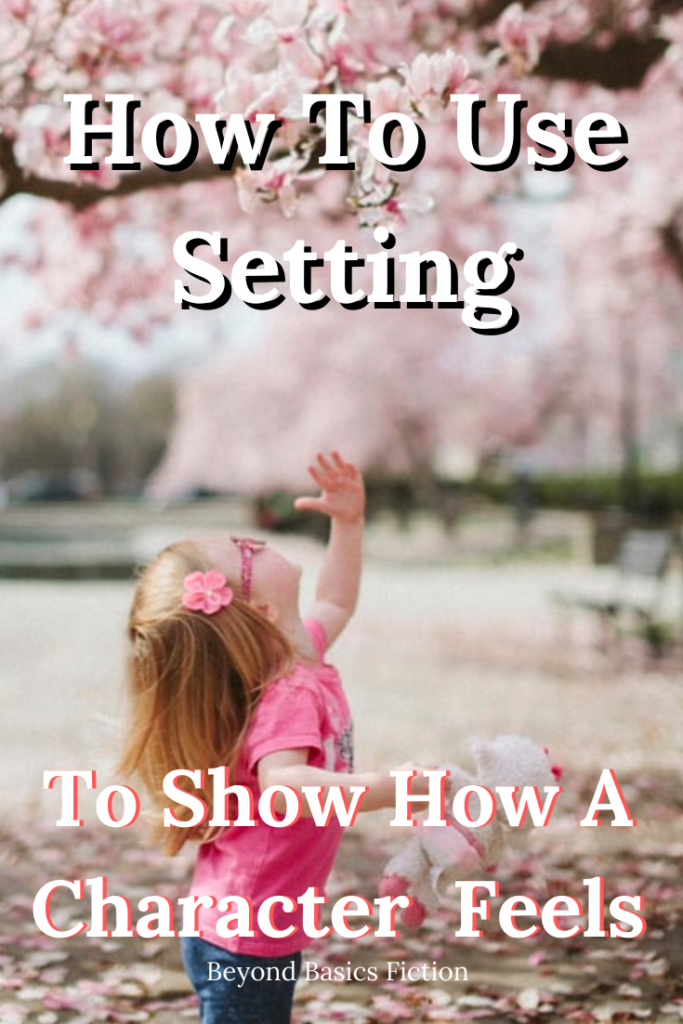
Are you writing (or wanting to write) in limited 3rd person POV or Deep POV? Many blogs write as though the these two popular fiction styles are the same and it muddies the water quite a bit leading to a great deal of confusion. Deep POV came out of limited third person, and they have some similarities, but they are in fact different in style and strategy.
Have you joined the free Facebook group Going Deeper With Emotions in Fiction where I share tips and teach about Deep POV?
Third person POV has a three different styles: omniscient third, objective third, and limited third. This distinction is important to understand the intent behind limited third person and how it differs from deep point of view.
- Omniscient third person uses an all-knowing narrator who not only reports on facts but may interpret those facts through the perspective (thoughts) of any of the characters. Neil Gaiman’s The Graveyard Book and Lemony Snicket’s A Series Of Unfortunate Events is an example of omniscient third.
- Objective third person is an all-knowing narrator who doesn’t go inside the character’s head much at all. The reader gets what the narrator observes. Hemingway wrote in objective third.
- Limited third person limits the narrator voice to one character’s experience (thoughts) at a time and usually with a very limited cast of characters. The reader gets one character’s point of view (at a time), but the story is told by the author. Limited third has varied flexibility in how strictly the author limits themselves.
Deep POV developed out of limited third person. Deep POV aims to remove the author/narrator voice entirely and write AS the character to create an immersive experience for readers. Here are the top ways I can think of that make these writing styles different.
Author Voice
In close 3rd person, the author is telling the story about the character. The reader is brought in close to the character’s perspective through dialogue and thoughts (internal dialogue), but the author or another narrator-type voice is telling the story. Because of this, the author voice can share a good deal of information that the point of view character doesn’t know, wouldn’t think, etc. Some author will limit how much of this they do, but it’s still not deep POV.
In Deep POV, you’re writing AS the character instead of about them. The reader experiences the story as the character experiences the story to create an immersive effect. (Learn more about immediacy here) That means, all those author-voice bits become author intrusion or telling in deep POV. The reader can only know what the point of view character knows, sees, hears, intuits, learns, etc. even when not writing speech or internal dialogue. Every word written comes from the POV character’s perspective.
Deep POV takes show don’t tell to all new levels, and many storytelling strategies that are acceptable in close third are considered telling — like naming an emotion (telling) instead of showing what that emotion feels like. This includes filter words like: saw, heard, noticed, and felt (although some writing in limited third eliminate these as well). This includes thinking words like thought, remembered, hoped, reminisced, and wanted. (Read more about author intrusion in deep POV here.) This forces the reader to lean in and engage with the character emotionally.
In Close 3rd: Sherry was terrified of her boss. He always yelled at her during breaks when she wasn’t doing anything wrong.
In deep POV: The boss walked towards Sherry. She trembled. What did I do wrong this time?
Character Voice
In close 3rd person point of view, the character’s voice predominately comes through in dialogue and thoughts (internal dialogue). Everything else written comes from the author, so you’re not limited to only what the point of view character knows, their vocabulary or prior knowledge, etc.
In deep pov, you are limited by these things. If your character Charlotte has car trouble, you are limited in how you can describe the problem by Charlotte’s knowledge of cars. If she doesn’t know a spark plug from an air filter, she won’t be able to open the hood and identify the problem or know the names of any of the engine components. She’ll just know the car isn’t working. In limited 3rd person, the author can fill in those details, use terminology Charlotte doesn’t know.
In limited 3rd person, the reader isn’t inside the character’s head all the time. This gives the writer more freedom to describe things. In close third, Sally can trudge through the door of the tavern and the author/narrator voice describes the place as a seething cesspool of vice. Sally may or may not share this opinion — remember the author is telling the story not Sally.
In deep POV, the way Sally feels about the tavern, and her motivations for staying there, her goals for that scene, will dictate how SHE thinks/talks about it.
Speech and Thought Tags
He/she said. He/she thought. These are tags and in close third person you’re free to use these. In fact, because readers are more likely to just skim over these without being pulled from the story, you’re encouraged to use these over others such as, he exclaimed.
In deep POV, tags aren’t used at all in favour of beats. A beat is an action that keeps the story moving ahead, SHOWS how a character feels, and attributes dialogue or thoughts. Further, in deep POV there’s no italics for internal dialogue (thoughts) because the reader knows who’s thinking or talking through context. Deep POV allows you to write a story in third person POV (he/she), and use first person for thoughts (internal dialogue) if you want to. (Read 8 FAQs About Deep POV Here.)
“What are you doing?” David said. His wife’s clothes sat piled high in a suitcase on the bed. His fists clenched in anger. She can’t leave him!
“What are you doing?” David shoved Sarah’s suitcase off the bed, dumping her clothes on the floor. She can’t leave me!
Keeping Secrets
In close third POV, the character is allowed to think/know things that the reader doesn’t. Because the reader only gets selected glimpses into the character through speech and thought, the author can keep the character’s plans or expectations a secret. Conversely, the author can share details with the reader that the point of view character doesn’t know.
In deep POV, if the character knows something, the reader knows it. So, you can’t send a character into a situation with a plan fully formed without the reader also knowing the plan. Using an unreliable narrator in deep POV still works so long as the character is lying not to the reader, but to themselves.
Know Each Style’s Strengths And Weaknesses
Bravo if you’ve made it this far!! Here’s the golden ticket, my friends. There are positives and negatives with each writing style, and neither is right or wrong. You can use deep POV with first or third POV, past or present tense. It’s really more of a question of genre (some genres trend more towards one style over another) and personal preference.
Now, those seeking a fail-safe template clutch your pearls. You can write a novel entirely in deep POV, or third person limited, or use a combination of both styles as fits the story. My advice is to thoroughly understand the techniques of each style, the effects those techniques aim to create, and then use them to create the effect you’re looking for. Afterall, you can use a wrench to pound in a nail if you want to, if you’re making a point about something, but often it’s more efficient to use a hammer. Make these styles work FOR you, don’t be enslaved to either one.

I love this bit of advice from David Mamet:
Use deep POV in scenes that call for it. You might write your book in limited third and reserve deep POV for scenes that warrant a more introspective look. “Sara noticed he wasn’t wearing his wedding ring and wondered if he deliberately took it off before he met up with her.” That’s an interesting observation in a story and worthy of deeper exploration. Cut the distance between Sara and the reader. “His wedding ring was missing. Did he take it off before he got here?”
What other differences between close third and deep POV have you noticed?



Thank you for this article Lisa. Especially the last paragraph (which pulls together those preceding it beautifully).
I’m clutching my pearls! And after taking (and continuing) DPOV courses with you, I can finally say I’ve found my story happy place. I’m writing an old-fashioned character, across 70 years of Australian history. Limited 3rd combined with DPOV fits my vision perfectly. From peer and early reader feedback – it’s working. Thank you so much.
Yes, that combination fits your genre and pushes the boundaries of it at the same time. There’s no right or wrong, but be sure it’s being done with a strategy behind it. The strategy is what people lack. The rules aren’t enough!
Such a brilliant post Lisa. Thank you. I do have one question about the reader knowing everything the pov character knows in deep pov. If it’s something the character has deliberately put behind her and doesn’t want to think about is it ok to hold that event/memory back until the character is ready to deal with it, and THEN share it with the reader? I’m thinking of my book Cross My Heart where Tess doesn’t want to face the issue from her past but is eventually forced to when she does the equine therapy. Would love to hear your thoughts.
A character that pushes a memory from their mind, or has buried it, isn’t keeping secrets – when done well. I had no issues with your character, you force to face the past in small ways with almost every chapter so her fight to prevent thinking of it felt genuine. That’s my two-cents anyways.
Hi Lisa,
I’m getting mixed messages here. Do you use italics when you use I in your characters thoughts or not? I’m trying to collect all the rules of 3rd deep pov so I can write it the right way. But everyone says something different. Xan you help me?
Julie
j2panasik@yahoo.com
I’ve given you mixed messages on italics? Typically, in limited third person, the narrative and internal dialogue are written in third person. Deep POV allows a story to be written in third person with internal dialogue in first person if you want – but it adds complexity that might not be needed.
Italics with internal dialogue is allowed in limited third person. It’s avoided in deep POV. The italics often take the place of he/she thought tags in close/limited third person.
Great write-up. I’m rewriting two of my novels into deep third-person POV. This article got me started.
Awesome! Keep at it! I like say – once you go deep, you never go back. 😀
Lisa, appreciate your Deep 3rd POV insights. If I understand correctly a different person per chapter can be used from their POV. My manuscript has different characters the first seven chapters until the main character comes into the story. Some of them will be killed off by the seventh chapter. So I’ve chosen four characters that have one or more chapters from their POV. Then the main character dominates most of the remaining 47 chapters.
Does it become confusing to have different characters per chapter POV leading to the main heroine? She carries the story for most of the remaining chapters.
Thanks Don
Usually, in most genres, you want to introduce the main character in chapter one. Waiting until chapter 7 and introducing six or seven other POV characters before would be confusing I would think. The reader wouldn’t know which character to cheer for. Just my two cents.
Hi Lisa. Just a quick question as I brush up on DPOV. In your examples, The boss walked towards Sherry. She trembled. What did I do wrong this time? and “What are you doing?” David shoved Sarah’s suitcase off the bed, dumping her clothes on the floor. She can’t leave me!
Is using pronouns and names like (she) trembled and (David) shoved, is this not author intrusion?
stephen recently posted…Interview in Irish Edition and New Poetry
Well, using he/she and names is what makes it third person, that’s not author intrusion.
“What are you doing?” David said. His wife’s clothes sat piled high in a suitcase on the bed. His fists clenched in anger. She can’t leave him!
If you cut off the him or me at the she can’t leave part it’s even closer imop, and feels like how a person would think.
“What are you doing?” David said. His wife’s clothes sat piled high in a suitcase on the bed. His fists clenched in anger. She can’t leave!
I’m troubled between deep point of view and third person omniscience because my POV character will come down with a mental illness that will alter her personality and ability to communicate effectively with other characters in the novel. Help! Can I change my POV character towards the end of the novel?
Depending on genre rules, generally you’re allowed to have more than one POV character. Limited Third Person is the writer telling one character’s story and adding in some of the character’s thoughts directly for readers. In deep POV, there is no author/narrator voice. Everything comes to the reader directly from the character. Deep POV lends itself well to stories that are driving by internal emotions, with a lot of introspection.
Hi Lisa,
I’m so grateful for this opportunity to ask questions and get answers from you. …I’ve been reading/studying different blogs for days in an attempt to clarify POV questions that originally had to do with deep POV. Thanks to you, and others, I believe I now understand deep POV, but other questions are driving me a bit crazy. These questions have to do with close POV: Is Close POV the same as Limited Omniscience, wherein the Narrator only knows/reports the POV character’s experience/thoughts? Or does Close POV give the otherwise limited narrator extra perception/knowledge, which she wouldn’t ordinarily possess, like the ability to know or see what the POV character can’t (blushing, etc.)? This extra bit of psychic ability is throwing me for a loop. How would the narrator put that knowledge to use–and why?